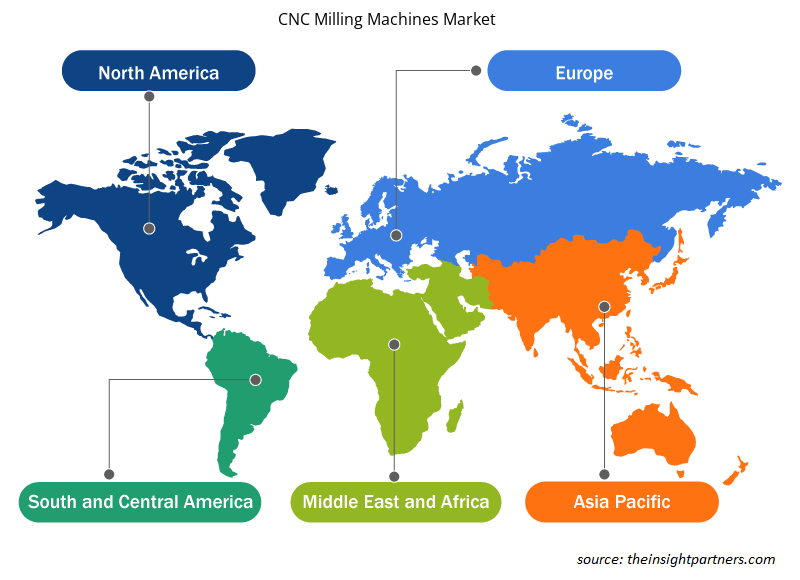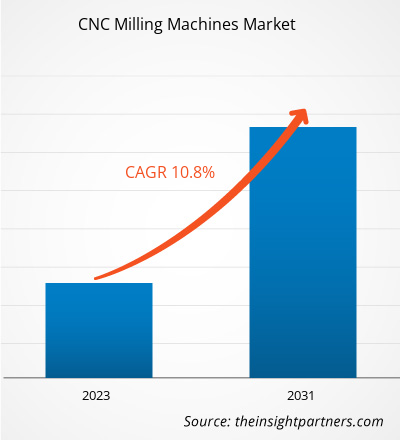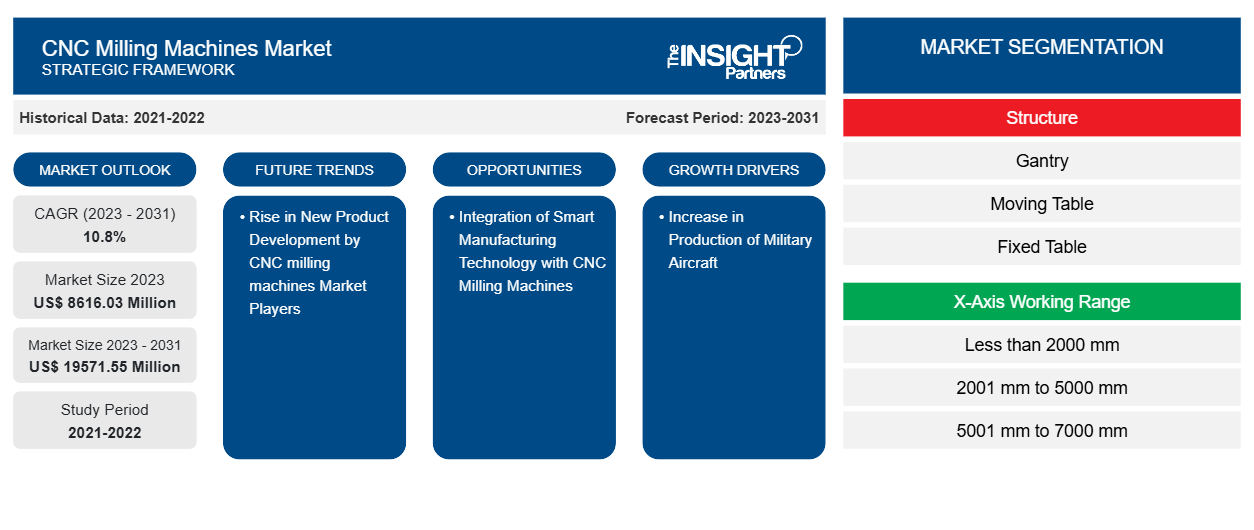Se proyecta que el tamaño del mercado de fresadoras CNC alcance los 19 571,55 millones de dólares estadounidenses en 2031, frente a los 8616,03 millones de dólares estadounidenses en 2023. Se espera que el mercado registre una CAGR del 10,8% en 2023-2031. La creciente demanda de vehículos eléctricos a nivel mundial está impulsando fuertemente la industria automotriz. La industria automotriz en todo el mundo está experimentando cambios significativos, como el aumento de la producción de vehículos eléctricos y vehículos autónomos. Muchos fabricantes de automóviles han aumentado su producción mediante la adopción de la automatización y la expansión de las plantas de producción en todo el mundo. Según la Agencia Internacional de Energía (AIE), las ventas de vehículos eléctricos (VE) casi se duplicaron en 2021 en comparación con 2020, a pesar de los cuellos de botella de la cadena de suministro y la pandemia de COVID-19. En 2021 se vendieron casi 6,6 millones de VE y un total de 16,5 millones de VE estaban presentes en las carreteras a nivel mundial. En 2021, se vendieron 3,3 millones de vehículos eléctricos en China, en comparación con 1,2 millones en 2020. La industria automotriz es uno de los mayores usuarios de fresadoras CNC. En la industria automotriz, las fresadoras CNC fabrican paneles interiores, motores de tracción y varias piezas personalizadas. El mecanizado CNC también ayuda a la industria automotriz a desarrollar prototipos funcionales, que pueden entrar en producción en masa después de las pruebas y la validación. Por lo tanto, el crecimiento de la industria automotriz está impulsando principalmente el mercado de las fresadoras CNC.
Análisis del mercado de las fresadoras CNC
La industria automotriz en todo el mundo está experimentando cambios significativos, como el aumento de la producción de vehículos eléctricos y vehículos autónomos. Muchos fabricantes de automóviles han aumentado su producción mediante la adopción de la automatización y la expansión de las plantas de producción en todo el mundo. A continuación se mencionan algunas de las nuevas plantas de fabricación inauguradas en los últimos años:
- En septiembre de 2021, Ford anunció la apertura de su nueva planta de fabricación de vehículos eléctricos en EE. UU. con una inversión de US$ 11.400 millones.
- En septiembre de 2022, Continental inauguró su nueva planta de producción automotriz en Texas con una inversión de US$ 110 millones.
- En octubre de 2021, Nissan anunció la apertura de su nueva planta de producción en Tochigi. La fábrica se dedica a la fabricación de vehículos de próxima generación para lograr la neutralidad de carbono.
La apertura de nuevas plantas de producción en todo el mundo está contribuyendo al aumento de la producción de vehículos. A continuación se menciona el aumento de la producción de vehículos en unidades en algunos países en 2022 en comparación con 2021:
|
País
|
2021
|
2022
|
% cambiar
|
|
Estados Unidos
|
9.167.214 |
10.060.339 |
10% |
|
Alemania
|
3.308.692 |
3.677.820 |
11% |
|
Porcelana
|
26.082.220 |
27.020.615 |
3% |
|
India
|
4.399.112 |
5.456.857 |
24% |
|
Indonesia
|
1.121.967 |
1.470.146 |
31% |
|
Sudáfrica
|
499.087 |
555.889 |
11% |
|
Argentina
|
434.753 |
536.893 |
24% |
Fuente: Organización Internacional de Constructores de Vehículos Automotores
Las fresadoras CNC se utilizan ampliamente en la producción de automóviles, incluida la fabricación de varias piezas, como paneles interiores, cajas de cambios, piezas personalizadas y motores. Por lo tanto, la creciente producción de automóviles en todo el mundo está impulsando la demanda de fresadoras CNC, lo que contribuye al crecimiento del mercado de fresadoras CNC.
Descripción general del mercado de fresadoras CNC
Las fresadoras de control numérico computarizado (CNC) son las máquinas más importantes para la fabricación sustractiva, que elimina materiales de la pieza de trabajo para crear un producto terminado. Esto difiere de los procesos de fabricación aditiva, como la impresión 3D, la fundición o el moldeo por inyección, en los que se agrega material para crear un producto terminado. El proceso comienza con una representación de diseño asistido por computadora (CAD) bidimensional o tridimensional de la pieza que se va a producir. El CAD guía el proceso de corte de la pieza de trabajo y define con precisión las medidas y los requisitos de la pieza. El fresado CNC fue el primer tipo de proceso CNC utilizado en 1952 y puede remodelar varios materiales como metal, vidrio, aleación, plástico o madera. Es el proceso CNC más común y se puede programar para producir piezas diseñadas a medida con especificaciones exactas y precisas. Actualmente, muchos actores del mercado ofrecen una amplia gama de productos con diversas especificaciones, tamaños y funcionalidades.
Personalice este informe según sus necesidades
Obtendrá personalización en cualquier informe, sin cargo, incluidas partes de este informe o análisis a nivel de país, paquete de datos de Excel, así como también grandes ofertas y descuentos para empresas emergentes y universidades.
-
Obtenga las principales tendencias clave del mercado de este informe.Esta muestra GRATUITA incluirá análisis de datos, desde tendencias del mercado hasta estimaciones y pronósticos.
Perspectivas regionales del mercado de fresadoras CNC
Los analistas de Insight Partners han explicado detalladamente las tendencias y los factores regionales que influyen en el mercado de las fresadoras CNC durante el período de pronóstico. Esta sección también analiza los segmentos y la geografía del mercado de las fresadoras CNC en América del Norte, Europa, Asia Pacífico, Oriente Medio y África, y América del Sur y Central.

- Obtenga datos regionales específicos para el mercado de fresadoras CNC
Alcance del informe de mercado de fresadoras CNC
| Atributo del informe | Detalles |
|---|---|
| Tamaño del mercado en 2023 | US$ 8616,03 millones |
| Tamaño del mercado en 2031 | US$ 19.571,55 millones |
| CAGR global (2023 - 2031) | 10,8% |
| Datos históricos | 2021-2022 |
| Período de pronóstico | 2023-2031 |
| Segmentos cubiertos |
Por estructura
|
| Regiones y países cubiertos |
América del norte
|
| Líderes del mercado y perfiles de empresas clave |
|
Densidad de actores del mercado de fresadoras CNC: comprensión de su impacto en la dinámica empresarial
El mercado de las fresadoras CNC está creciendo rápidamente, impulsado por la creciente demanda de los usuarios finales debido a factores como la evolución de las preferencias de los consumidores, los avances tecnológicos y una mayor conciencia de los beneficios del producto. A medida que aumenta la demanda, las empresas amplían sus ofertas, innovan para satisfacer las necesidades de los consumidores y aprovechan las tendencias emergentes, lo que impulsa aún más el crecimiento del mercado.
La densidad de actores del mercado se refiere a la distribución de las empresas o firmas que operan dentro de un mercado o industria en particular. Indica cuántos competidores (actores del mercado) están presentes en un espacio de mercado determinado en relación con su tamaño o valor total de mercado.
Las principales empresas que operan en el mercado de fresadoras CNC son:
- Corporación Okuma
- Corporación Nidec
- NICOLÁS CORREA
- Sudamérica
- AWEA MECANTRONIC CO., LTD.
- EMCO GmbH
Descargo de responsabilidad : Las empresas enumeradas anteriormente no están clasificadas en ningún orden particular.

- Obtenga una descripción general de los principales actores clave del mercado de fresadoras CNC
Noticias y desarrollos recientes del mercado de fresadoras CNC
El mercado de las fresadoras CNC se evalúa mediante la recopilación de datos cualitativos y cuantitativos a partir de una investigación primaria y secundaria, que incluye publicaciones corporativas importantes, datos de asociaciones y bases de datos. A continuación, se incluye una lista de los avances en el mercado en cuanto a innovaciones, expansión comercial y estrategias:
- En enero de 2023, EMCO y GLM se convertirán en EMCO GLM GMBH. Tras una fase preparatoria muy exitosa, en la que la cooperación de las dos empresas en las áreas de ventas, tecnología de aplicaciones, automatización y servicio ya ha tenido un buen comienzo, se inició la fundación de la nueva empresa EMCO GLM GmbH, con una participación mayoritaria de EMCO. (Fuente: EMCO, nota de prensa)
- En diciembre de 2022, TRIMILL entregó con éxito una fresadora TRIMILL VFC 3021 de 5 ejes a un cliente en Alemania. La fresadora está equipada con un cabezal de fresado de horquilla de 2 ejes T21C, diseñado para fresado continuo y que proporciona alta precisión y rigidez. TRIMILL afirmó que ofrece a sus clientes soluciones de fresado personalizadas y de alta calidad, así como su capacidad para entregar e instalar máquinas en todo el mundo con éxito. (Fuente: TRIMILL, Nota de prensa)
Informe de mercado sobre fresadoras CNC: cobertura y resultados
El informe “Tamaño y pronóstico del mercado de fresadoras CNC (2021-2031)” proporciona un análisis detallado del mercado que cubre las siguientes áreas:
- Tamaño y pronóstico del mercado de fresadoras CNC a nivel global, regional y nacional para todos los segmentos clave del mercado cubiertos por el alcance.
- Dinámica del mercado, como impulsores, restricciones y oportunidades clave
- Tendencias del mercado de fresadoras CNC
- Análisis detallado de las cinco fuerzas de Porter y PEST y FODA
- Análisis del mercado de fresadoras CNC que cubre las tendencias clave del mercado, el marco global y regional, los principales actores, las regulaciones y los desarrollos recientes del mercado
- Panorama del mercado de fresadoras CNC y análisis de la competencia que cubre la concentración del mercado, análisis de mapas de calor, actores destacados y desarrollos recientes.
- Perfiles detallados de empresas
- Análisis histórico (2 años), año base, pronóstico (7 años) con CAGR
- Análisis PEST y FODA
- Tamaño del mercado, valor/volumen: global, regional y nacional
- Industria y panorama competitivo
- Conjunto de datos de Excel
Informes recientes
Testimonios
Razón para comprar
- Toma de decisiones informada
- Comprensión de la dinámica del mercado
- Análisis competitivo
- Información sobre clientes
- Pronósticos del mercado
- Mitigación de riesgos
- Planificación estratégica
- Justificación de la inversión
- Identificación de mercados emergentes
- Mejora de las estrategias de marketing
- Impulso de la eficiencia operativa
- Alineación con las tendencias regulatorias























 Obtenga una muestra gratuita para - Mercado de fresadoras CNC
Obtenga una muestra gratuita para - Mercado de fresadoras CNC